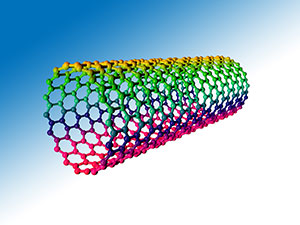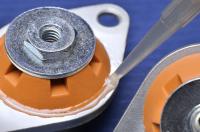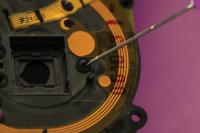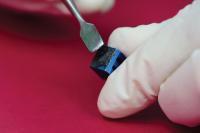 Nanoparticles filled epoxy adhesives have been developed to meet the rigorous requirements of the electronic, optical, aerospace, and automotive industries. Nano fillers are blended into specific epoxy formulations to enhance key mechanical, electrical, thermal, and optical properties. Additionally, they can be added to products either in conjunction or without conventional fillers. They can be loaded at a much lower level compared to their micro-particle filler counterparts, yet yielding similar and in most cases better overall property enhancement.
Nanoparticles filled epoxy adhesives have been developed to meet the rigorous requirements of the electronic, optical, aerospace, and automotive industries. Nano fillers are blended into specific epoxy formulations to enhance key mechanical, electrical, thermal, and optical properties. Additionally, they can be added to products either in conjunction or without conventional fillers. They can be loaded at a much lower level compared to their micro-particle filler counterparts, yet yielding similar and in most cases better overall property enhancement.
Commercialization of nanoparticles between 1 to 100 nanometers (nm), including alumina and silica, to name a couple has shown much promise in the development of structural adhesives, encapsulants, conformal coatings, and underfills. Even after long-term aging tests like exposing the composite systems made using such nanofillers, to 1000 hours at 85° C and 85% RH, negligible change in the bulk properties such as the hardness of the product was observed. This test is widely regarded as a good indicator of reliability, especially in fiber optic type applications. Nano-reinforced epoxy systems exhibit improvement in physical strength properties, such as fatigue performance, higher dimensional stability, durability, and impact resistance. Certain types of nanoparticles can contribute to lowering coefficient of thermal expansions, imparting thermal conductivity, lowering shrinkage and also providing toughness to the matrix. Moreover, specialty compounds can be engineered to be employed over extreme temperature ranges.
Advantages and dispersion techniques of nano-filled epoxies
Nanoparticles can be incorporated in epoxies to:
- Enhance dimensional stability
- Reduce the coefficient of thermal expansion and shrinkage
- Improve impact resistance
These results were achieved by adding a low content of nanofillers and using proper dispersion techniques. Epoxy adhesive systems can be designed to ensure structural integrity and often times replace brazing, soldering, welding, or mechanical fastening. Another important determining factor of utilizing nanofillers is the capability of such products to be applied in thin sections, thereby leading to lighter weight units. Some of the other advantages of adhesive bonding include uniform stress distribution over the entire bonded area, protection against corrosion, and the ability to absorb shocks. These liquid polymeric compositions are easily dispensed manually, semi-automatically, or automatically. Special fluid dispensing equipment can precisely deposit amounts as small as a few micro-liters of the material for high volume attachment applications.
Master Bond’s nanoreinforced adhesives
As industry requirements have transformed, there is a need for light weighting in automotive and aerospace, corrosion and fatigue resistance in maritime, and weatherability and recyclability in energy and infrastructure. Nanofilled epoxy polymer composites have played a pivotal role in meeting these growing demands. Improvement in manufacturing processes, reduced cycle times and the simultaneous blending of multiple nanofillers will continue to spur new innovations.
Master Bond has made considerable progress in compounding nanoreinforced compounds. EP113 is an ultra low viscosity two component, heat curing, nanosilica filled epoxy system, which is ideal for potting and encapsulation. This compound has a long working life after mixing, excellent physical strength properties, and a wide serviceable temperature range. It has been successfully tested to withstand 1,000 hours at 85°C/85% Relative Humidity. It features optical clarity as well as outstanding electrical insulation characteristics and is ideal for use in opto-electronic type applications involving rigorous temperature as well as dielectric requirements.
Another epoxy system, EP30NS, features a nanosilica filler with high abrasion resistance where independent tests demonstrated that this epoxy’s abrasion resistance value is significantly higher than that of a typical epoxy composition. It is optically clear, especially in thin sections, and meets NASA low outgassing specifications.
Nano-graphene filled EP30NG is a two component room temperature curing epoxy. It is a paste, it offers good physical strength properties, and very high thermal conductivity (> 5 W/mK). It is an ideal fit for applications where high heat transfer and low thermal resistance are desirable. The mix ratio for this epoxy is 100:16 by weight.
Nanoparticle Filled Coatings
Advanced liquid based epoxy coatings incorporating nanoparticles have greatly enhanced their protective, functional, as well as aesthetic properties. More significantly, these systems comply with RoHS requirements, and can be employed in severe conditions, providing exceptional abrasion/scratch resistance, corrosion/erosion protection, dimensional stability and high temperature capability. They are also serviceable as a barrier to liquids/gases thereby capable of providing a hermetic seal. This has enabled their use even on high cost machinery employed in demanding applications. These nanoparticle filled coatings exhibit outstanding adhesion, very good weatherability, and guard against harsh environmental conditions, as well as temperature fluctuations.
Future Research
There are many types of nanofillers that can be used to improve certain physical strength properties of adhesives, such as tensile strength, modulus, fracture toughness, and impact resistance, as well as electrical & thermal properties such as electrical and/or thermal conductivity. Some of them include graphene, nano-alumina, nano-clay, and nano-silver, to name a few.
Featured Nanosilica Filled Epoxy Compounds
 |
EP113 Two component nanosilica filled epoxy for potting, coating and sealing. Optically clear. Low shrinkage. Superior electrical insulation properties. Toughened system. Successfully tested for 1,000 hours 85°C/85% RH. Serviceable from -100°F to +450°F. |
 |
EP30NS Moderate viscosity Nanosilica epoxy resin system. High strength rigid bonds. Lower linear shrinkage after cure. Serviceable from -60°F to +300°F. Cures readily at room temperature. Passes ASTM E595 for NASA low outgassing. |
 |
EP30NG Graphene filled epoxy. Non-drip system for bonding and sealing. Cures at room temperature. Superior abrasion resistance. |
